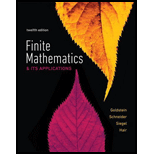
Industrial Production A factory that produces threedimensional models has two 3D printers. Printer A is very reliable and produces 200 models every week. Printer B is a little less reliable and produces 201 models on 99% of the weeks, but breaks down and produces 0 models the rest of the weeks.
(a) In a random week, what is the probability that Printer B produces more models that Printer A?
(b) After 200 weeks have elapsed, what it the probability that Printer B has produced more total models than Printer A? Hint: Printer A will have produced 40,000 models. If Printer B breaks down at least once, it will have produced fewer models.
Want to see the full answer?
Check out a sample textbook solution
Chapter 6 Solutions
Finite Mathematics & Its Applications (12th Edition)
Additional Math Textbook Solutions
Pathways To Math Literacy (looseleaf)
Elementary Statistics ( 3rd International Edition ) Isbn:9781260092561
Intermediate Algebra (13th Edition)
Graphical Approach To College Algebra
Probability And Statistical Inference (10th Edition)
APPLIED STAT.IN BUS.+ECONOMICS
- Refer to page 9 for a problem requiring finding the tangent plane to a given surface at a point. Instructions: Use partial derivatives to calculate the equation of the tangent plane. Show all calculations step-by-step. Link [https://drive.google.com/file/d/1wKSrun-GlxirS31Z9qoHazb9tC440AZF/view?usp=sharing]arrow_forwardRefer to page 8 for a problem involving solving a second-order linear homogeneous differential equation. Instructions: Solve using characteristic equations. Show all intermediate steps leading to the general solution. Link: [https://drive.google.com/file/d/1wKSrun-GlxirS3IZ9qoHazb9tC440AZF/view?usp=sharing]arrow_forwardRefer to page 17 for a problem requiring solving a nonlinear algebraic equation using the bisection method. Instructions: Show iterative calculations for each step, ensuring convergence criteria are satisfied. Clearly outline all steps. Link [https://drive.google.com/file/d/1wKSrun-GlxirS31Z9qo Hazb9tC440AZF/view?usp=sharing]arrow_forward
- Problem: The probability density function of a random variable is given by the exponential distribution Find the probability that f(x) = {0.55e−0.55x 0 < x, O elsewhere} a. the time to observe a particle is more than 200 microseconds. b. the time to observe a particle is less than 10 microseconds.arrow_forwardThe OU process studied in the previous problem is a common model for interest rates. Another common model is the CIR model, which solves the SDE: dX₁ = (a = X₁) dt + σ √X+dWt, - under the condition Xoxo. We cannot solve this SDE explicitly. = (a) Use the Brownian trajectory simulated in part (a) of Problem 1, and the Euler scheme to simulate a trajectory of the CIR process. On a graph, represent both the trajectory of the OU process and the trajectory of the CIR process for the same Brownian path. (b) Repeat the simulation of the CIR process above M times (M large), for a large value of T, and use the result to estimate the long-term expectation and variance of the CIR process. How do they compare to the ones of the OU process? Numerical application: T = 10, N = 500, a = 0.04, x0 = 0.05, σ = 0.01, M = 1000. 1 (c) If you use larger values than above for the parameters, such as the ones in Problem 1, you may encounter errors when implementing the Euler scheme for CIR. Explain why.arrow_forwardRefer to page 1 for a problem involving proving the distributive property of matrix multiplication. Instructions: Provide a detailed proof using matrix definitions and element-wise operations. Show all calculations clearly. Link [https://drive.google.com/file/d/1wKSrun-GlxirS3IZ9qoHazb9tC440AZF/view?usp=sharing]arrow_forward
- Refer to page 30 for a problem requiring solving a nonhomogeneous differential equation using the method of undetermined coefficients. Instructions: Solve step-by-step, including the complementary and particular solutions. Clearly justify each step. Link [https://drive.google.com/file/d/1wKSrun-GlxirS3IZ9qoHazb9tC440AZF/view?usp=sharing]arrow_forwardRefer to page 5 for a problem requiring finding the critical points of a multivariable function. Instructions: Use partial derivatives and the second partial derivative test to classify the critical points. Provide detailed calculations. Link [https://drive.google.com/file/d/1wKSrun-GlxirS31Z9qo Hazb9tC440AZF/view?usp=sharing]arrow_forwardRefer to page 3 for a problem on evaluating limits involving indeterminate forms using L'Hôpital's rule. Instructions: Apply L'Hôpital's rule rigorously. Show all derivatives and justify the steps leading to the solution. Link [https://drive.google.com/file/d/1wKSrun-GlxirS31Z9qo Hazb9tC440AZF/view?usp=sharing]arrow_forward
- 3. Let {X} be an autoregressive process of order one, usually written as AR(1). (a) Write down an equation defining X₁ in terms of an autoregression coefficient a and a white noise process {} with variance σ². Explain what the phrase "{} is a white noise process with variance o?" means. (b) Derive expressions for the variance 70 and the autocorrelation function Pk, k 0,1,. of the {X} in terms of o2 and a. Use these expressions to suggest an estimate of a in terms of the sample autocor- relations {k}. (c) Suppose that only every second value of X is observed, resulting in a time series Y X2, t = 1, 2,.... Show that {Y} forms an AR(1) process. Find its autoregression coefficient, say d', and the variance of the underlying white noise process, in terms of a and o². (d) Given a time series data set X1, ..., X256 with sample mean = 9.23 and sample autocorrelations ₁ = -0.6, 2 = 0.36, 3 = -0.22, p = 0.13, 5 = -0.08, estimate the autoregression coefficients a and a' of {X} and {Y}.arrow_forward#8 (a) Find the equation of the tangent line to y = √x+3 at x=6 (b) Find the differential dy at y = √x +3 and evaluate it for x=6 and dx = 0.3arrow_forwardRefer to page 96 for a problem involving the heat equation. Solve the PDE using the method of separation of variables. Derive the solution step-by-step, including the boundary conditions. Instructions: Stick to solving the heat equation. Show all intermediate steps, including separation of variables, solving for eigenvalues, and constructing the solution. Irrelevant explanations are not allowed. Link: [https://drive.google.com/file/d/1wKSrun-GlxirS31Z9qoHazb9tC440AZF/view?usp=sharing]arrow_forward
- Algebra & Trigonometry with Analytic GeometryAlgebraISBN:9781133382119Author:SwokowskiPublisher:Cengage
 College AlgebraAlgebraISBN:9781305115545Author:James Stewart, Lothar Redlin, Saleem WatsonPublisher:Cengage Learning
College AlgebraAlgebraISBN:9781305115545Author:James Stewart, Lothar Redlin, Saleem WatsonPublisher:Cengage Learning
 College Algebra (MindTap Course List)AlgebraISBN:9781305652231Author:R. David Gustafson, Jeff HughesPublisher:Cengage Learning
College Algebra (MindTap Course List)AlgebraISBN:9781305652231Author:R. David Gustafson, Jeff HughesPublisher:Cengage Learning Holt Mcdougal Larson Pre-algebra: Student Edition...AlgebraISBN:9780547587776Author:HOLT MCDOUGALPublisher:HOLT MCDOUGAL
Holt Mcdougal Larson Pre-algebra: Student Edition...AlgebraISBN:9780547587776Author:HOLT MCDOUGALPublisher:HOLT MCDOUGAL




